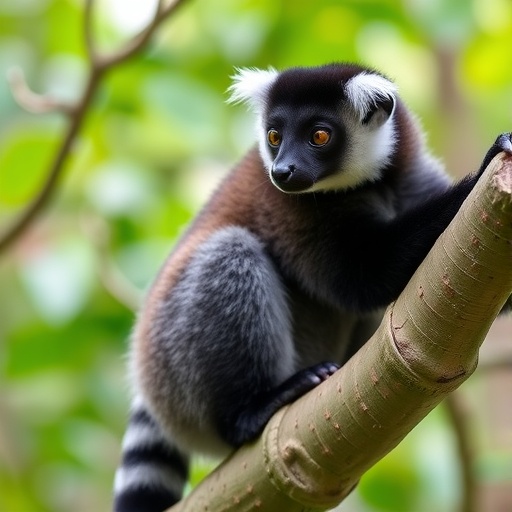In a groundbreaking collaborative study conducted by the Department of Medicine and Life Sciences (MELIS) at Pompeu Fabra University alongside the University of Trento in Italy, researchers have unveiled the intricate composition of the gut microbiome of the indri (Indri indri), a critically endangered lemur species endemic to Madagascar’s northeastern rainforests. This pioneering research marks the first comprehensive analysis of the intestinal microbiota in these socially complex primates, offering unprecedented insights into their unique microbial ecosystems and the potential implications for conservation biology.
The indri, locally revered and known as babakoto, is an arboreal folivorous primate confined exclusively to the biodiversity-rich tropical forest canopy of northeastern Madagascar. With a highly specialized diet primarily consisting of leaves, fruits, seeds, flowers, and bark, the indri also occasionally ingests soil, a behavior whose biological ramifications have long intrigued primatologists and microbial ecologists. Given its critical status on the IUCN Red List due to rapid habitat loss fueled by anthropogenic activity and climate change, understanding every facet of the indri’s biology, including its symbiotic microbial communities, is paramount to designing effective conservation strategies.
This inter-institutional research team utilized a refined experimental pipeline incorporating metagenomic sequencing and genome assembly techniques to decode microbial DNA extracted from fecal and soil samples collected from six distinct social groups across the indri’s fragmented habitat. The dual sampling approach allowed scientists to disentangle the contributions of environmental reservoirs versus host-to-host transmission in shaping the gut microbiota profile. Remarkably, the analysis identified 48 discrete bacterial species constituting the indri’s intestinal flora, with a staggering 47 of these species previously unclassified by microbiological databases, highlighting a vast unexplored microbial diversity intrinsic to this host.
Of particular note, Escherichia coli emerged as the solitary known bacterial inhabitant within the microbiome, predominantly detected in groups inhabiting forest edges adjacent to human settlements. This finding elucidates potential anthropogenic influences on microbial colonization in isolated wildlife populations, raising concerns about zoonotic exchange and habitat perturbation. According to lead researcher Mireia Vallès Colomer from MELIS-UPF, these results underscore an evolutionary co-dependence whereby the indri and its microbiota have co-evolved in isolation, creating a highly specific microbial consortium that may be integral to the primate’s nutrition and immune defenses.
Beyond cataloging the bacterial taxa, the study shed light on microbial transmission dynamics within indri social structures. These lemurs exhibit monogamous, matriarchal families generally consisting of two to five individuals that occupy discrete, non-overlapping territories with limited intergroup contact. Intriguingly, the research demonstrated that bacterial strains are largely conserved within these social units but differ genetically between groups, suggesting vertical and horizontal transmission pathways reinforce microbiome specificity and that environmental acquisition from soil is negligible despite the animals’ soil ingestion behaviors. Nicola Segata of the University of Trento further elaborates that the correlation between bacterial genetic distances and geographic separation of host populations indicates microbial evolution in concert with host population isolation.
This discovery of socially mediated microbiome transmission introduces a novel paradigm in our understanding of host-microbial ecology among wild primates. It intimates that the health and resilience of the indri are tied not just to habitat preservation but also to maintaining intact social networks that facilitate microbial inheritance. Disruptions in these social units, whether by fragmentation, hunting pressure, or environmental degradation, could inadvertently diminish microbial diversity and thereby compromise host fitness—a factor seldom considered in traditional conservation approaches.
Despite limitations imposed by sample size and the logistical challenges inherent to fieldwork in remote Madagascan forests, the methodological rigor of computational metagenomic analysis undertaken here sets a new standard for wildlife microbiome studies. The use of advanced bioinformatics to assemble high-quality bacterial genomes directly from environmental samples heralds a transformative step forward, enabling researchers to detect rare and host-specific microbial taxa that conventional culturing methods might overlook.
Moreover, this investigation into the indri’s gut microbiome enriches our broader comprehension of primate evolutionary biology and symbiosis. The specificity of these newly identified bacterial species to the indri suggests co-adaptive evolutionary processes extending beyond macroscopic traits into the microbial realm, potentially influencing digestion of fibrous plant materials, detoxification of secondary plant metabolites, and resistance to pathogens. Such insights pave the way for comparative studies across other endangered lemurs and primates, potentially uncovering microbial biomarkers linked to health and conservation status.
Given that these unique microbial communities risk extinction alongside their host, this research amplifies the urgency of biodiversity conservation through a microbiological lens. The preservation of the indri’s microbiota equates to safeguarding integral functional components of the rainforest ecosystem that remain invisible to the naked eye yet vital to ecological balance. The study’s findings advocate for integrative conservation strategies that encompass not only habitat protection but also the maintenance of social behavioral dynamics essential for microbiome transmission.
Moving forward, the researchers emphasize the necessity for expanded longitudinal studies to monitor microbiome stability over time and under varying environmental stressors. Such efforts could illuminate the potential impacts of climate change and habitat encroachment on microbial diversity and host health, ultimately informing adaptive management policies. There is also scope for harnessing microbiome knowledge therapeutically, potentially through fecal microbiota transplants amongst captive breeding programs (should conservation efforts progress to captivity), even though current attempts to maintain indri populations ex situ have been unsuccessful.
In summation, this pioneering research on the gut microbiome of Indri indri not only uncovers a carpet of novel bacterial species residing within an endangered primate but also weaves a compelling narrative connecting microbial ecology, social behavior, and conservation biology. The revelation that the survival of these unique microbiomes depends wholly on the persistence of their host species spotlights an underappreciated dimension of biodiversity loss. As such, this study represents a clarion call to broaden the conservation paradigm to embrace microbial symbionts as essential partners in the fight against extinction.
Subject of Research:
Not applicable
Article Title:
Bacterial transmission within social groups shapes the underexplored gut microbiome in the lemur Indri indri
News Publication Date:
25-Jul-2025
Web References:
10.1093/ismejo/wraf136
References:
The ISME Journal
Image Credits:
Filippo Carugati
Keywords:
Microbiota, Gut microbiota, Biodiversity conservation, Endangered species, Biodiversity, Extinction, Primates




